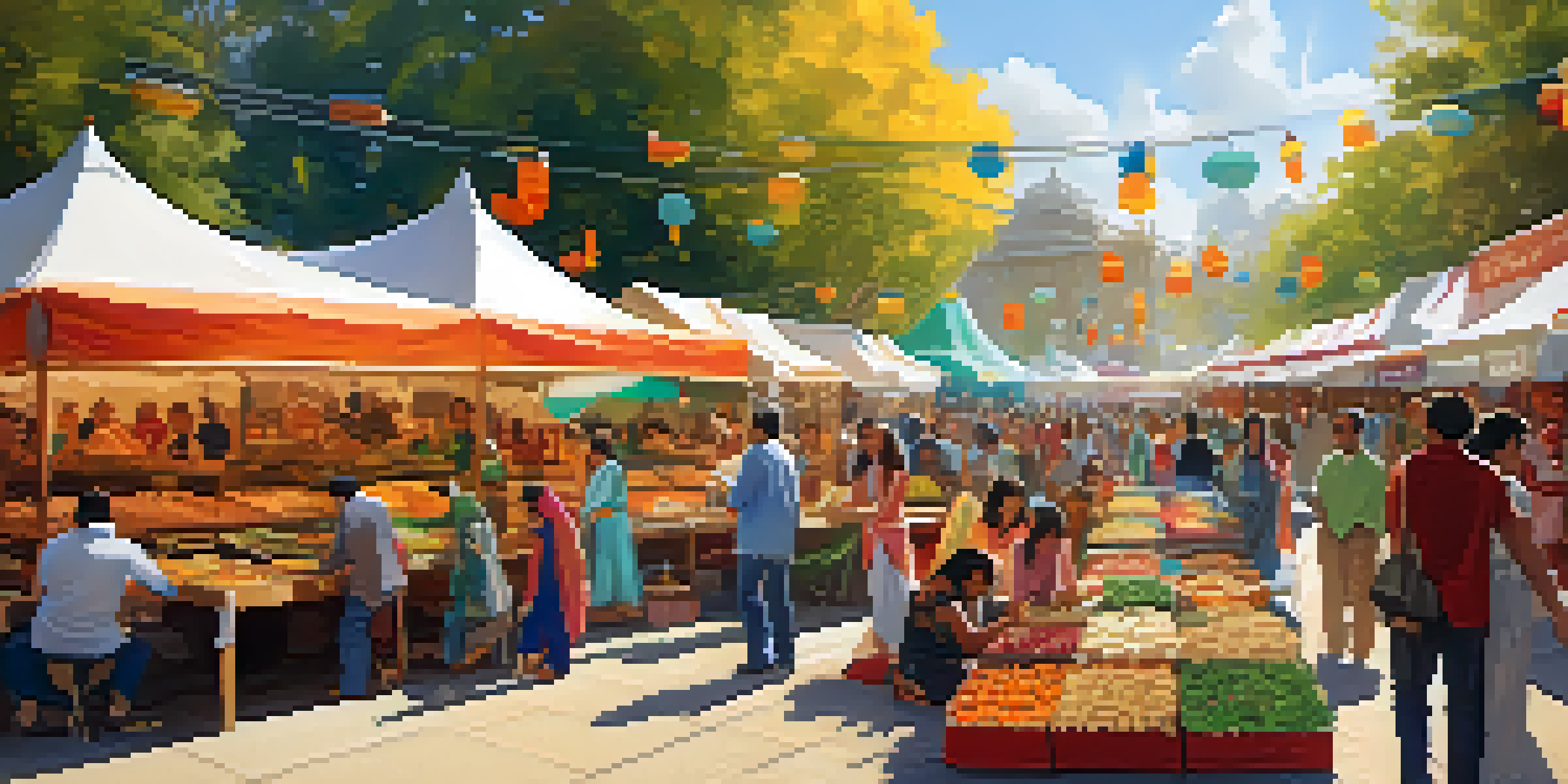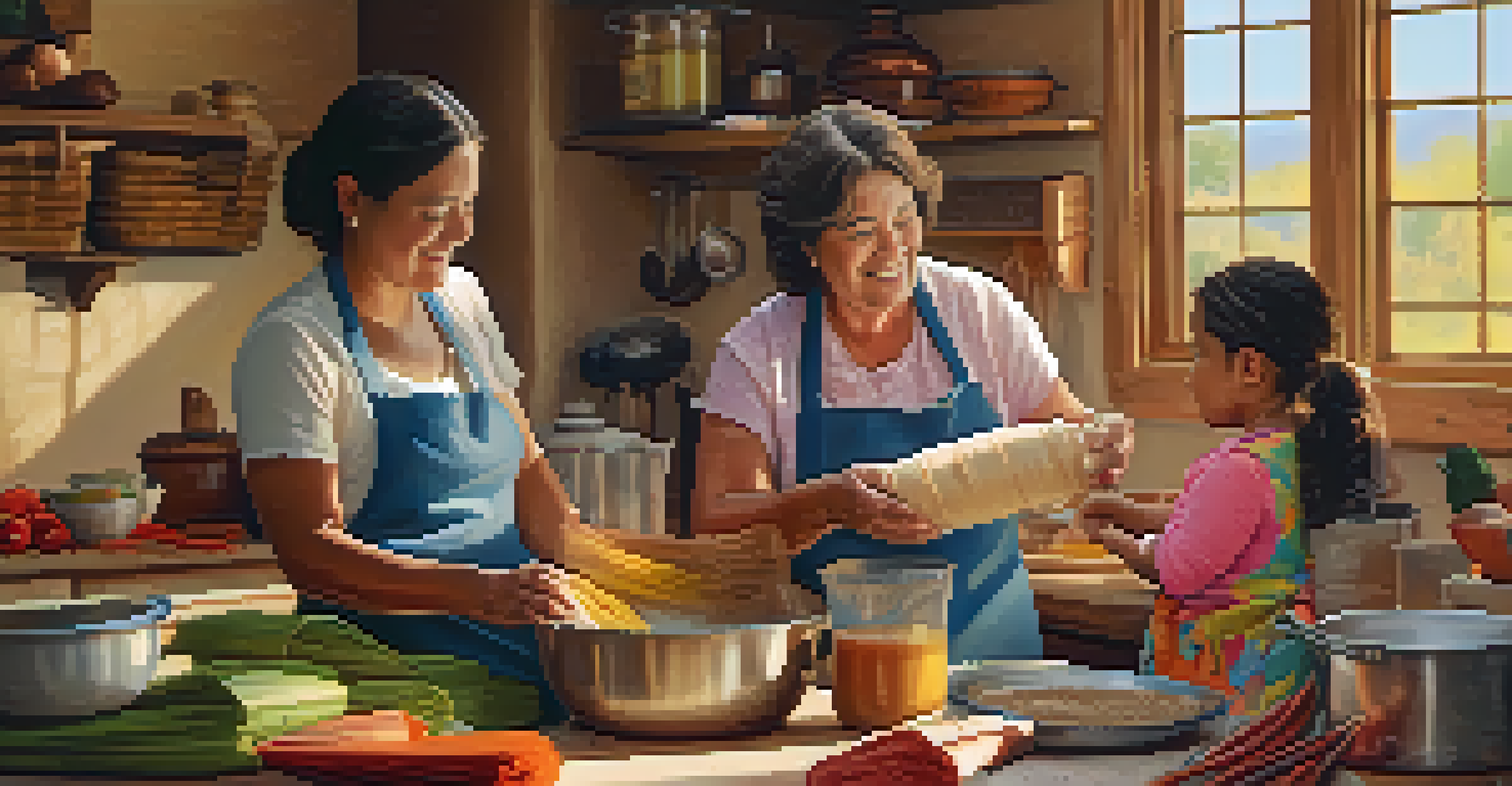How Culinary Arts Foster Cross-Cultural Connections

Culinary Arts as a Universal Language
Food is often referred to as a universal language, transcending barriers and connecting people from diverse backgrounds. When we gather around a table, the act of sharing a meal invites conversation and camaraderie. Culinary arts allow individuals to express their culture and heritage through flavors and techniques, creating a rich tapestry of experiences that everyone can enjoy.
Food is our common ground, a universal experience.
For example, a dish like paella from Spain or sushi from Japan tells a story of its origins and the people who created it. These meals are not just about nourishment; they embody tradition, history, and community. As we taste different cuisines, we engage with the cultures they represent, fostering understanding and appreciation.
Moreover, culinary arts encourage curiosity and exploration. When someone tries a new dish, they are not just tasting flavors; they are participating in a cultural exchange. This openness paves the way for deeper connections, as food becomes a bridge that connects hearts and minds across geographical divides.
Food Festivals: Celebrating Cultural Diversity
Food festivals serve as vibrant showcases of culinary diversity, bringing together communities to celebrate their unique flavors and traditions. These events often feature local chefs and home cooks, allowing them to share their heritage while promoting cross-cultural understanding. From the spicy aromas of Indian curry to the sweet notes of French pastries, festivals create an immersive experience that engages all the senses.

Attending a food festival can be likened to taking a mini-vacation around the world. You can sample dishes from different countries, learn about their culinary practices, and even participate in cooking demonstrations. This hands-on approach fosters an appreciation for various cultures while creating lasting memories.
Food as a Cultural Connector
Culinary arts serve as a universal language, fostering connections and understanding among diverse cultures through shared meals and experiences.
Furthermore, food festivals often include music, art, and performances that reflect the cultural themes of the cuisine being presented. This holistic experience enhances the sense of community and connection, inviting people to celebrate their differences while finding common ground through the love of food.
Cooking Classes: Learning and Sharing Cultures
Cooking classes provide an interactive platform for individuals to learn about different culinary traditions while honing their skills. These classes often attract people from various backgrounds, eager to connect over a shared love for cooking. As participants chop, sauté, and stir, they exchange stories and experiences that enrich their understanding of each other’s cultures.
Cooking is like love. It should be entered into with abandon or not at all.
For instance, a Thai cooking class might not only teach participants how to make Pad Thai but also share the cultural significance of the dish and its ingredients. This educational aspect fosters a deeper connection to the food and the culture it represents, encouraging participants to engage with it long after the class ends.
Additionally, cooking classes often culminate in communal meals, where everyone enjoys the fruits of their labor together. This shared experience strengthens bonds and creates a sense of belonging, illustrating how culinary arts bring people together in meaningful ways.
Family Recipes: A Legacy of Cultural Exchange
Family recipes are a cherished aspect of culinary arts, often passed down through generations as a way to preserve cultural heritage. These recipes carry stories, traditions, and memories, making them invaluable tools for connecting individuals to their roots. When families gather to prepare these dishes, they not only nourish their bodies but also their souls, fostering a sense of identity and belonging.
For example, a grandmother's secret recipe for tamales might spark conversations about family history and cultural traditions. As younger generations learn to make these dishes, they become custodians of their culture, ensuring that it continues to thrive. This process of sharing and learning reinforces familial bonds and encourages a sense of pride in one's heritage.
Food Festivals Celebrate Diversity
Food festivals bring communities together, showcasing unique culinary traditions while promoting cross-cultural understanding and appreciation.
Moreover, when families share their recipes with friends or participate in potlucks, they extend this cultural exchange beyond their immediate circle. Such interactions promote understanding and appreciation, allowing people to experience the richness of diverse culinary traditions.
Social Media: A Platform for Culinary Connection
In today's digital age, social media has emerged as a powerful platform for promoting culinary arts and fostering cross-cultural connections. Food bloggers, chefs, and home cooks alike share their culinary creations online, inviting others to explore different cuisines from the comfort of their homes. This virtual interaction creates a global community united by a passion for food and culture.
Platforms like Instagram and TikTok allow users to discover and engage with diverse cooking styles and techniques. A viral recipe can lead to discussions about its origins, prompting users to delve deeper into the culture behind it. This digital exchange broadens horizons and encourages individuals to experiment with new flavors and cooking methods.
Furthermore, social media offers a space for cultural storytelling through food. Chefs and home cooks can share the significance of their dishes, creating a narrative that enriches the dining experience. This storytelling approach fosters empathy and understanding, reminding us that food is not just sustenance but a reflection of our shared human experience.
Travel: Exploring Cultures Through Culinary Experiences
Travel often provides some of the most authentic culinary experiences, allowing individuals to immerse themselves in different cultures through their food. From street vendors to fine dining establishments, exploring local cuisine offers a unique glimpse into a region's traditions and values. These encounters often leave a lasting impact, as travelers return home with new perspectives and appreciation for diverse cultures.
For example, trying a traditional meal in an Italian nonna's kitchen can be a transformative experience. The warmth of her hospitality, combined with the flavors of her family recipes, creates a memory that transcends mere tourism. Such experiences deepen the connection between food and culture, highlighting the importance of culinary arts in understanding global diversity.
Cooking Classes Foster Cultural Exchange
Interactive cooking classes provide a platform for cultural exchange, allowing participants to learn about and connect with different culinary traditions.
Moreover, engaging with locals during culinary adventures fosters meaningful connections. Sharing a meal with a family or participating in a cooking class not only enhances one’s culinary skills but also builds friendships and bridges cultural divides. These interactions serve as reminders of our shared humanity and the power of food to unite us.
Culinary Arts in Global Diplomacy
Culinary arts have found a unique role in global diplomacy, where food acts as a medium for fostering international relations. State dinners and cultural exchange programs often feature carefully curated menus that reflect the host country’s culinary heritage. This thoughtful approach to dining serves not just to nourish but also to build rapport and understanding among nations.
For instance, when leaders share a meal that highlights the flavors of their respective cultures, it can create a relaxed atmosphere conducive to open dialogue. The shared experience of breaking bread can help ease tensions and promote collaboration, showcasing the power of culinary arts in diplomacy.

Additionally, culinary diplomacy extends beyond formal events. Food festivals and cultural exchange initiatives allow countries to showcase their culinary prowess, inviting others to experience their culture firsthand. This form of soft power enhances mutual respect and appreciation, cementing culinary arts as a vital tool in building cross-cultural connections.